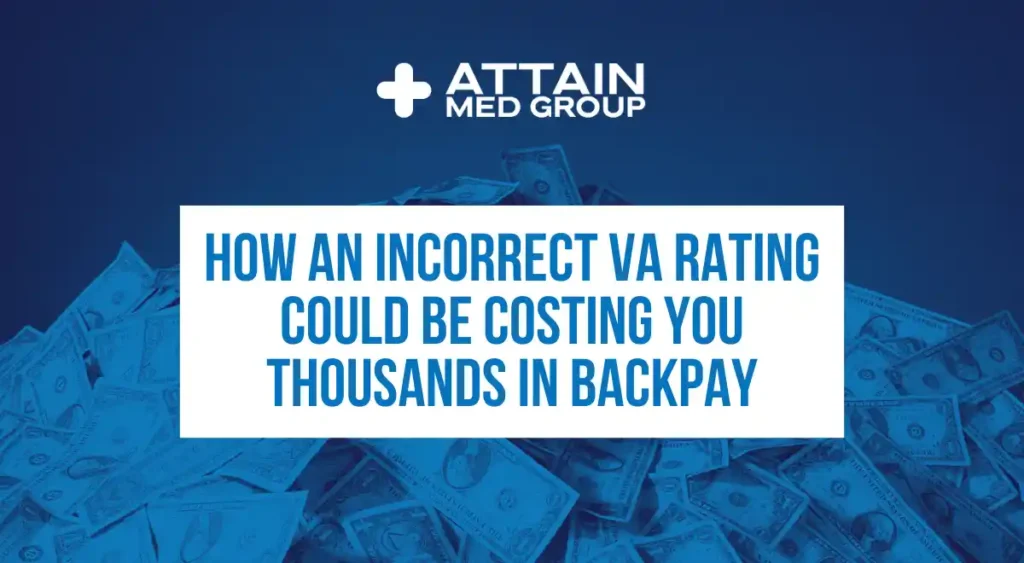You’re looking at your VA decision letter, and the number just doesn’t feel right. You know your condition is worse than they say. This feeling is a pit in your stomach, a mix of frustration and exhaustion because you are missing out on disability benefits you need. This is a common story for many veterans, leading to significant backpay loss due to incorrect VA rating. Learn how expert medical evidence can help secure a proper rating and unlock years of missed compensation, because it’s the key to turning things around.

What you are feeling is valid, and there is a path forward. The journey to correct a VA disability rating may seem difficult, but understanding the process is the first step. It is about getting the disability compensation you rightfully earned for your service-connected disability.
What is VA Backpay and Why is it So Important?
VA backpay is also known as retroactive benefits. It is the money the VA owes you from the effective date of your claim until the day your disability claim is finally approved at the correct rating. This is not a bonus; it is pay owed for the time you were waiting for the right decision.
Your effective date is critically important in the pay calculation. Generally, the VA sets this as the date they received your initial claim, but an earlier date can be argued if evidence shows your disability began sooner. An earlier effective date can mean thousands, or even tens of thousands of dollars, in retroactive benefits.
An incorrect VA disability rating means the monthly VA pay amount is wrong. This mistake gets multiplied over all those months, and sometimes years, of the va claims process. That results in a substantial loss of the additional compensation you should have received.
The Common Reasons Your VA Rating is Wrong
So, why does a veteran disability rating come back incorrect? Often, the problem starts with the Compensation and Pension (C&P) exam. These exams are supposed to objectively evaluate your condition, but sometimes the examiner might not fully grasp the severity of your disability and how it affects your daily life.
Perhaps the exam felt rushed, or the examiner didn’t ask the right questions about your mental health or physical limitations. This can lead to a report that doesn’t paint a full picture of your service-connected condition. The result is a lower va rating than you deserve.
Another common issue is incomplete evidence in your original claim. The VA makes decisions based on the file in front of them. If your service treatment records or post-service medical reports don’t clearly connect your disability to your time in the military, the VA might deny the VA disability claim or assign a low rating.
When an Unmistakable Error Occurs
Sometimes, the VA makes a clear and unmistakable error (CUE). This isn’t just a disagreement with the decision; it’s a situation where the VA made an obvious mistake of fact or law based on the evidence available at the time. A CUE claim is a powerful tool because, if successful, it can change the effective date back to the original claim, unlocking years of backpay.
Examples of CUEs include the VA overlooking key evidence that was in the file or misinterpreting a law that was in effect when the decision was made. Filing CUE claims requires a specific legal argument. It’s different from a standard claim appeal that introduces new evidence.
Proving an unmistakable error can be challenging, but it’s an important option to consider if you believe a fundamental mistake was made on your claim. It highlights a breakdown in the VA claims process that directly impacted your VA award. Success here means correcting a past injustice and receiving all the pay owed to you.
How Expert Medical Evidence Corrects Your Rating and Secures Backpay
This is where you can take back control of your va claim. While the VA has to consider all evidence, strong, credible medical evidence carries significant weight. This is not about submitting more paperwork; it’s about submitting the right kind of paperwork to support your disability claims.
Expert medical evidence gives the VA what it needs to see your disability in a new light and justify a higher rating. It can directly challenge the findings of a flawed C&P exam. This is how you begin to fix the problem and secure the disability compensation you deserve.
What Qualifies as “Expert Medical Evidence”?
We are not just talking about your regular checkup notes from your family doctor. Expert medical evidence is a deeper, more detailed opinion from a qualified medical professional who speaks the VA’s language. This strong evidence is often the deciding factor in the appeals process.
A huge part of this is an Independent Medical Opinion (IMO), often referred to as a Nexus Letter. This is a detailed report written by a private doctor who reviews your entire C-file, treatment records, and personal statements. They then provide a professional medical opinion connecting your disability to your military service.
This evidence is powerful because it is objective and thorough. A specialist, like a psychologist for military sexual trauma (MST) or an orthopedist for a back injury, can explain the true impact of your condition with medical authority. Their medical reports provide the detailed rationale that a VA rater needs to grant a rating increase.

How a Strong Medical Opinion Changes Everything
A solid medical opinion does one job incredibly well: it fills in the blanks that your service records or C&P exam left open. It explains the “how” and “why” of your service-connected disability in clear, medical terms. This is essential for any veteran trying to receive benefits.
For example, it can clearly state that your current sleep apnea is, more likely than not, aggravated by your service-connected PTSD. This creates the “nexus,” or link, that the VA must see to grant secondary service connection. It provides a solid, medically-backed reason for a higher VA disability rating.
Essentially, you are presenting a professional counterargument to the VA’s initial decision. According to the VA’s own rules, they must weigh all credible evidence, and a well-written expert opinion is highly credible. It forces a reevaluation of your VA disability claim based on new and material medical facts.
Steps to Take to Challenge an Incorrect Rating
So, what do you actually do? It starts with a careful review of what the VA told you in your rating decision letter. This document is your roadmap, explaining why they awarded a certain percentage.
It tells you exactly what points you need to argue against with new evidence. Understanding their reasoning is the first step in building a successful claim appeal. From there, you can begin to gather the necessary documentation.
- Get Your C-File: You’ll need to get a copy of your claims folder, or C-file, from the VA. This file contains every piece of evidence the VA used, including the C&P exam you’re questioning. You need to see what they see by filing VA Form 20-10206.
- Gather Lay Evidence: This includes statements from you, your spouse, family members, or fellow service members who can attest to your condition and how it impacts you. These “buddy letters” can be powerful in showing the full extent of your disability over time.
- Obtain Expert Medical Evidence: Find a qualified, private medical professional who understands the VA disability benefits system. They can review your file and write a powerful IMO or Nexus Letter. This new, strong evidence will form the backbone of your appeal.
- Choose Your Appeal Lane: Once you have your new medical evidence, you can file a Supplemental Claim. This path is specifically for adding new and relevant evidence to your case. It essentially tells the VA, “You missed something important, please look at this.” Other options include a Higher-Level Review if you believe an error was made on the existing evidence, or an appeal to the Board of Veterans’ Appeals.

Real-World Scenarios: How Veterans Won Their Backpay
Let’s imagine a Marine veteran with a 10% rating for a knee injury for over a decade. He lived with constant pain that the low rating didn’t reflect. He finally got an IMO from an orthopedic surgeon specializing in knee injuries.
The surgeon’s report included a detailed review of his service records, post-service MRIs, and a current examination. The report clearly argued his knee condition was much more severe and met the criteria for a 60% rating. The veteran submitted this as a Supplemental Claim and was awarded the higher rating, which came with over ten years of backpay at the corrected rate.
Or think about an Army veteran initially denied service connection for PTSD related to military sexual trauma. Her C&P exam was brief, and the examiner wrongly concluded her symptoms were not related to her service. She worked with a private psychologist who specialized in sexual trauma and understood the unique circumstances of such claims.
The psychologist wrote a detailed nexus letter, linking her specific symptoms directly to the traumatic events from her service. This powerful evidence directly challenged the C&P examiner’s opinion. The VA reversed its decision, granting the veteran service connection, a 70% disability rating, and years of missed compensation.
Another case could involve a Vietnam veteran exposed to Agent Orange who developed a presumptive condition years later. His original claim might have been denied before the condition was added to the presumptive list. Filing a new claim with updated medical evidence can establish the connection and secure retroactive benefits back to when the law changed.
Calculating Your Potential Backpay
Understanding how backpay is calculated can provide powerful motivation during the appeals process. The basic pay calculation involves taking the difference between the monthly payment you received and the monthly payment you should have received. This difference is then multiplied by the number of months from your effective date.
Several factors determine the final amount. These include annual cost-of-living adjustments (COLAs), which increase the VA disability compensation rate over time. Your dependent status also plays a significant role, as having a spouse, children, or dependent parents adds to your monthly pay.
While online VA pay calculator tools can give you a rough estimate, the VA performs the official calculation once a new rating is awarded. The key takeaway is that correcting even a 10% or 20% rating error over several years can result in a substantial sum. This is money that can provide critical financial stability for you and your family.
Don’t Give Up on the Money You Earned
The VA claims process can feel like a full-time job. It is draining, and it can be tempting to just accept a low rating to be done with it. We urge you not to settle for less than you deserve.
The disability benefits you are fighting for are not a handout. You earned them through your service and sacrifice for our country. Fighting for the correct VA disability rating is about getting the care and compensation you are owed to manage your service-connected conditions.
You are not alone in this fight. There are resources and professionals. Remember that you are your own best advocate on this journey to secure your rightful benefits.

Conclusion
It is incredibly disheartening to receive a VA rating that you know is wrong. It can feel like your struggles are being dismissed, and the financial impact of that decision is very real. The backpay loss due to incorrect VA rating can affect your family’s stability, but it is not the final word on your claim.
Overcoming this loss is not just about getting more money; it’s about getting the respect and recognition you deserve for your service-connected disabilities. By understanding the system, gathering strong evidence, and presenting a medically sound argument, you can change the outcome. Expert medical evidence can help secure a proper rating and unlock years of missed compensation, allowing you to recover the benefits you rightfully earned.

